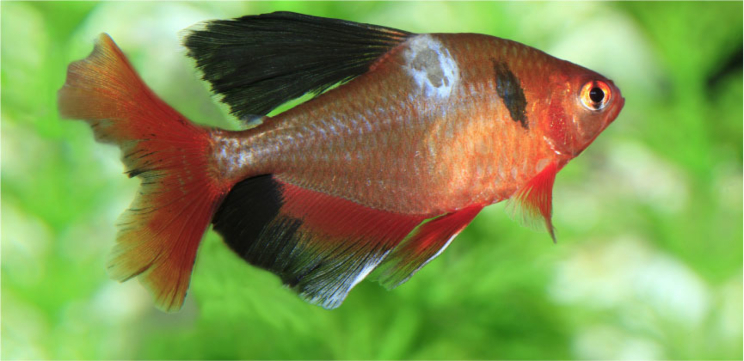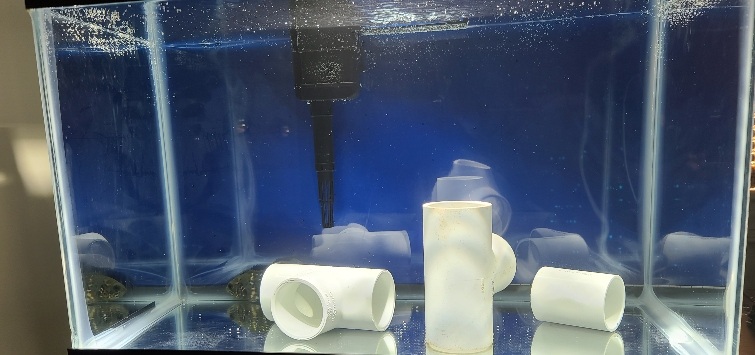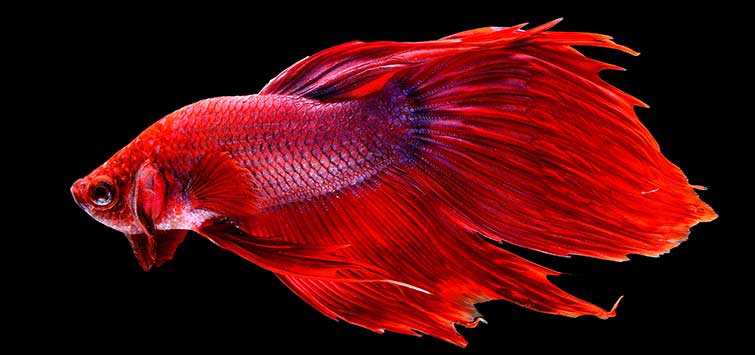Troubleshooting Aquarium Fish Health Problems
Nora Hickey, DVM and Jennifer Reynolds, MA
At one point or another, everyone encounters an aquarium fish health problem. It might be a bump that grows on a betta’s fin, an outbreak of white spots in a school of tetras, or a cichlid that is wasting away. While it can be easy to descend into the rabbit hole of trying to figure out exactly what is wrong with a sick fish, achieving an exact diagnosis requires equipment and training beyond the reach of most hobbyists. “The Fish Ladies” from fishkeepandchill.com have prepared this guide to help hobbyists navigate safe and effective approaches to address common fish health problems in home aquariums.
Just like other animals, fish can get infections from viruses, bacteria, and parasites, as well as develop cancer, nutritional diseases, and degenerative conditions. Whole textbooks have been written about diseases of aquarium fish, and some scientists have dedicated their entire careers to studying certain fish diseases. The sheer amount of information and possible causes hobbyists encounter when researching problems like white spots on the skin or eroding fins can be overwhelming and leave them unsure of what to do. Hobbyists also often encounter misinformation about fish health problems and, in some cases, may unknowingly follow bad advice that results in unintended harm to their fish.
Hobbyists do not have the same tools or training as professionals, which means that they need a different problem-solving approach to aquarium fish health problems than what veterinarians use. Hobbyists can be more accurate in their identification of fish health problems by focusing on classifying the problems into broad general categories rather than trying to diagnose specific fish diseases. Then, they can perform targeted, low-risk interventions that are safe and effective for managing the general category of condition affecting their fish.
The Professional’s Approach: Diagnostic Testing
Veterinarians do not look at a sick fish and instantly come to a diagnosis. They have a problem-solving process that they follow that includes a thorough physical examination of the fish, microscopically evaluating samples, such as of the mucus (slime coat) and gill, and performing additional diagnostic testing, such as bloodwork and ultrasound imaging. Each of these steps in the process can help veterinarians confirm a specific diagnosis, such as the bacterial infection columnaris disease or a chromatophoroma, a benign but unsightly tumor common in betta fish.
External parasites are a good example of a fish health problem easily diagnosed by a professional but challenging for home aquarists to correctly identify. Ichthyophthirius multifiliis (commonly known to hobbyists as ich or white spot) and Epistylis can be definitively diagnosed by collecting a skin scrape from the fish and identifying the parasites under a microscope. However, while hobbyists without a microscope and parasite identification training can see that their fish have white spots and may strongly suspect an external parasite infestation, they can’t determine the exact parasite responsible for the white spots.
Hobbyists who want an exact diagnosis and professional treatment of their fish can employ the services of a fish veterinarian. They can be hard to find, but a good place to start is the American Association of Fish Veterinarians’ Find a Fish Vet locator at fishvets.org. Fish vets can do everything from prescribing antibiotics for bacterial infections to performing surgery to remove tumors, and they can be an invaluable resource for particularly dedicated hobbyists.
Hobbyists who are unable to access veterinary care for their fish can still work through and manage a fair number of fish diseases successfully by themselves. An exact diagnosis is not a requirement to address many common aquarium fish health problems. Hobbyists facing such problems should focus on optimizing husbandry, correctly placing health problems into broad categories, and implementing practical treatments that will not harm the fish.

The Hobbyist’s Approach: Fundamental First Steps
Several actions should be taken if a fish health problem is noticed in a home aquarium:
• Isolate sick fish: Sick fish should be promptly removed to a hospital tank for several reasons. If they have infectious fish diseases, removing them from the main aquarium prevents them from infecting other fish. It also prevents the sick fish from being bullied by other fish.
• Test the water quality: Water quality testing should always be performed at the first sign of any fish health problem. At a minimum, determine the ammonia, nitrite, and pH levels. (For more information about how to address common water quality problems, see “Getting Your Sea Legs: What to Consider When Stocking a First Aquarium,” TFH Nov/Dec 2024.)
• Maintain excellent tank hygiene: Large-volume water changes (50 percent or more) are required if there is high ammonia or nitrite in the aquarium, but they are also beneficial even if the water quality is perfect. This is because water changes remove organic debris and infectious organisms from the water. Small ultraviolet filtration units can also help reduce pathogen levels in home aquariums.
• Promote health: Offer high-quality food that is optimal for your specific species of fish. Flake and pellet food should be used before its expiration date and kept dry and cool. High-quality frozen foods like bloodworms, daphnia, and mysis shrimp are excellent options for many fish. Sheets of dried algae or blanched fresh vegetables are high-quality food sources for herbivorous species.
The Hobbyist’s Approach: External Problems
External problems affect the outside surface of the fish, including the skin and fins. Some of the most common external problems home aquarists encounter include white spots on the skin and ulcerated fins (“fin rot”). Infectious agents, including parasites, water molds, and bacteria, as well as cancer, are some of the most common causes of external problems in home aquarium fish.
Skin Problems
The defining feature of this category is that the fish’s skin does not look right. There might be white spots, cottony patches, broken skin, or slimy areas. Some of the most notorious fish diseases in the aquarium hobby fall into this category, including ich, water mold (commonly called “cotton” or “fungus”), and columnaris disease. Many of the causes of skin problems are infectious, which means that it is particularly important to promptly remove affected fish so that they do not pass their problem onto other fish in the aquarium.
Aquarium salt is the best and safest first step for treating skin problems. A concentration of at least three parts per thousand (ppt) salt will kill many skin parasites. Use aquarium salt—not reef or marine salt, which contains extra buffers and other additives which could affect the pH and hardness in a freshwater aquarium. When calculating salinity, parts per thousand is equivalent to grams of salt per liter of water.
The most accurate way to dose salt is to calculate how many grams per liter of water you will dose (for example, 3 grams per liter) and weigh the salt using a kitchen scale or any scale accurate to the gram. If you know how many gallons your tank is, convert gallons to liters first (there are 3.785 liters per U.S. gallon). So, for example, a 10-gallon aquarium contains approximately 37.8 liters of water. To achieve a salinity of 3 ppt, multiply 37.8 liters x 3 grams per liter, resulting in 113.4 grams of salt.
It can be shocking to see the amount of salt you need to add to your aquarium to achieve a therapeutic concentration, but if you double-check your calculation (target grams per liter x tank volume in liters) and weigh the salt, you can be confident you’re adding the right amount. Dissolve the salt into a brine solution in a separate container before gently mixing it into the aquarium water. For extra caution, salt may be added slowly over a period of 12 to 24 hours while observing your fish’s reaction.
It may take several days before you see improvement, especially if the cause of the problem was skin parasites. Parasites often need to develop to certain stages in their life cycle before they are susceptible to treatment.
When salt is not enough, products with formalin and malachite green can be expected to work against many external parasites that commonly cause skin problems in aquarium fish, including ich and Epistylis, as well as water molds and the dinoflagellate Piscinoodinium (“velvet”).
Some fish species are particularly sensitive to certain chemicals; for example, catfish, tetras, and loaches do not tolerate aquarium fish disease treatments with malachite green well. Chemicals such as formalin and malachite green can be harder on fish than salt, and they might be too harsh for particularly delicate or compromised fish. Careful measuring and application are critical to the safe use of any chemical added to an aquarium, and, often, carbon needs to be removed from the filter so that it does not adsorb chemicals and render them ineffective. Several causes of skin problems are beyond the capacity of a hobbyist to address. One example is tumors, which are common in betta fish. These will not respond to salt or other chemical treatments and will require the services of a professional to effectively treat.
Fin Problems
Fin problems are usually caused by the same suspects as skin problems, but for this category of problems, bacterial infections move higher up on the list of most common causes. Salt is a good first step for addressing fin problems. Treating bacteria can require slightly higher concentrations than parasites, with 3 to 5 ppt sometimes being needed to effectively manage bacterial infections. As mentioned above, this works out to be 3 to 5 grams per liter.
When salt does not work to treat fin problems, products with hydrogen peroxide and peracetic acid may have an increased effect against bacteria infecting fish’s fins. Be sure to follow any and all label recommendations for dosage.
The Hobbyist’s Approach: Internal Problems
Internal problems are those that are happening inside the fish, and they can present in many different ways. Dropsy is a common term to describe when the fish’s coelom (belly) distends and its scales look bumpy. On the other hand, a fish may develop a sunken belly and become very skinny. Clinical signs such as crooked bodies and negative or positive buoyancy can also indicate problems happening inside the fish.
Internal problems are often caused by advanced fish diseases processes that are not easily treated by a home aquarist. For example, the belly distension and raised scales seen with dropsy happen because the fish’s organs are shutting down, and its body is retaining water. Organ failure is a very serious condition that requires hospitalization for treatment.
When home aquarists encounter fish with these types of serious internal problems, they should stick to the fundamentals. Isolation, excellent hygiene and nutrition, and adding salt to the water are all ways to support the fish without doing any harm.
Because most chemicals hobbyists can access are meant for killing pathogens and not treating systemic conditions such as organ failure or inflammation, fishkeepers should avoid adding too many chemicals to the water that could cause the fish additional stress. If possible, consult a fish veterinarian, whose ability to use injectable medications can greatly increase their effectiveness in treating serious internal problems.
The Hobbyist’s Approach: First Do No Harm
When a fish gets sick, it is tempting to try many different aquarium fish disease treatments to cover all of the possible causes. People often believe that this approach can only help their fish; however, sometimes it causes harm. Chemicals that are therapeutic at one dosage can be deadly at higher dosages. And if hobbyists are not careful with the product they purchase and their calculations, measurements, and administration of these chemicals, they can accidentally make their fish’s health worse.
This is one reason that salt is one of the best first treatments to try for any sick fish. Most freshwater fish species can tolerate therapeutic concentrations of salt for weeks. Salt also has the added benefit of supporting osmoregulation, which is the fish’s ability to maintain appropriate water and electrolyte concentrations in its body.
There are problems with indiscriminate treatment beyond direct harm to an individual fish. Many of the antibiotics commonly used by hobbyists do not treat the type of bacterial infections that most commonly affect fish. For example, the bacteria that cause columnaris disease and Aeromonas infections cannot be effectively treated with antibiotics such as erythromycin. Using the wrong antibiotic can promote antibiotic resistance and result in further difficulty treating future bacterial infections.
Hobbyists should strongly consider working with a veterinarian if their fish need to be treated with antibiotics. Veterinarians can diagnose the specific bacteria causing an infection and recommend the most effective antibiotic. In addition, they can use injectable antibiotics, which are often more effective against bacterial infections than antibiotics administered in the water.
The Hobbyist’s Most Powerful Tool: Prevention
After any aquarium fish health problem, good fishkeepers reflect on why their fish became sick. This can include recognizing that failing to quarantine new arrivals introduced an external parasite, inadequate water changes led to poor water quality and fin rot, or aggression prevented a smaller fish from accessing food. Usually, there is an important underlying problem that contributed to why fish became sick, and understanding this can help prevent future problems.
Hobbyists’ best tool for keeping happy, healthy fish is to learn from their mistakes and focus on preventing fish health problems from developing in the first place. When fish do get sick, their keepers should focus on optimizing husbandry and sticking to safe and simple treatments targeted at larger problems rather than specific diseases. For fish with advanced fish diseases and severe problems, consider working with a fish veterinarian to most effectively manage these conditions.
For more advice from Nora and Jen, including detailed explanations of fish diseases and advice about how to treat fish with aquarium salt, visit fishkeepandchill.com.

.png?h=595&iar=0&w=2781&hash=5FD5E69473BCC22199FBFA2FB71B6033)




